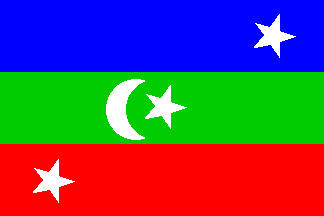 image by Ivan Sache, 31 March 2007
image by Ivan Sache, 31 March 2007
Last modified: 2025-02-22 by ian macdonald
Keywords: suvadiva | united suvadive republic |
Links: FOTW homepage |
search |
disclaimer and copyright |
write us |
mirrors
 image by Ivan Sache, 31 March 2007
image by Ivan Sache, 31 March 2007
See also:
The short-lived "United Suvadive Republic" was composed of the three atolls of Addu, Huvadu and Fua Mulaku. Suvadiva is an alternative name for Huvadu Atoll, sometimes the One and
a half degree Channel is called Suvadiva channel.
For ages, the affluent merchants from the southern atolls of Addu and
Huvadu had been trading directly with Ceylon and the East Indies,
which prevented the Maldive authorities from taxing that trade, which
did not pass through Malé, the capital of the Maldives. After the
Second World War, the British diplomats stationed in Colombo, upon
request of the Maldive authorities, imposed passports and visas issued
in Malé to Maldivians travelling to the British possessions. This
control, as well as the enforcement of the poll and land tax, was
bitterly resented in the southern atolls. The Maldive authorities
imposed a ban on trade between the British troops stationed in Addu and
the locals, causing the wrath of the Addu aristocracy and a riot
severely repressed by the government militia.
The Brits left the atoll in 1944 but came back in 1957 because of the
Cold War. The ban on trade was reimposed by the authorities. The
civilian British contractor expected a 100-year lease of land in
Hithadoo to build a staging post, which was difficult to obtain
legally; accordingly, he spread the idea of breaking away from the Malé
rulers and employed several Addus, significantly increasing their
income. In 1958, the new Prime Minister of the Maldives ordered to stop
all construction in Addu. Riots broke out in Hithadoo; on 3 January
1959, the independence was proclaimed and Abdulla Afeel Didi was
appointed head of state upon British recommendation. The prosperity of
Addu encouraged rebellion in the two neighbouring atolls of Fua Mulaku
and Huvadu, which joined Addu to form the United Suvadive Republic on
13 March 1959. The Huvadu rebellion was suppressed in July 1959 by a
gunboat commanded personally by the Prime Minister; a British regiment
prevented any action in Addu.
In 1960, the Brits withdrew their support to the rebellion but the
Suvadive Republic resisted. A new revolt in Huvadu was suppressed in
1961; the population was dispersed and the leaders of the rebellion
most all died in jail in Malé. Britain was more and more
internationally embarrassed by the secessionists; on 22 September
1963, the British political agent in Addu spelt out an ultimatum to the
people of Maradoo to hoist the Maldive flag. A man found the design of
the flag in a book and made it with bunting supplied by the British. At
3 AM on 23 September 1963, the Suvadive flag was cut down and the
Maldive flag hoisted over Maradoo. Following Maradoo's capitulation, the
British quickly spread the word that only those who were under the
sovereign authority of the Sultan of the Maldives would be employed in
British facilities. That was the final blow on the United Suvadive
Republic.
The Sultan proclaimed a general pardon and no punitive action was taken
by his government against anyone in Addu following the collapse of the
United Suvadive Republic. Afeef Didi was later pardoned by the
President of the Republic; he visited Addu once before he died in the
Seychelles.
[Maldives Royal Family website]
Ivan Sache & Johnny Andersson, 31 March 2007
A photo of President Afif of the Suvadive Islands (1959-1963), taken at a state ceremony in Hitadu Island, Addu Atoll at the beginning of 1960, shows in the background the flag of the Suvadive Republic. The flag is horizontally divided dark blue-green-red. The (relatively large) stars and the small crescent moon are white. Note that the centers of the stars are exactly aligned in diagonal.
Xavier Romero-Friars, 5 April 2004
Left, as shown by Barraclough - Image by António Martins, 28 December 2016
Right, as shown in the Flags of Aspirant Peoples chart - Image by Ivan Sache, 6 July 2000
Quoting Barraclough's Flags of the World [c2b81]:
Whilst the British were in occupation of Gan the people of Addu and the southern group of islands formed the United Suvadivian (sic) Republic with a flag of its own, in opposition to the Maldives government. The flag was horizontally blue, green and red, with a crescent and star over all in the centre and a star in the upper hoist and lower fly, all in white. The breakaway state was suppressed in late 1963.
Mark Sensen, 23 July 1996
The Flags of Aspirant Peoples chart [eba94] shows a slightly different flag as #146, with the following caption:
UNITED SUVADIVIAN REPUBLIC
Early 1960s
South Maldives Islands
The positions of the stars are lower hoist - center - upper fly, thus forming an ascending line.
Harald Müeller, 27 July 1996